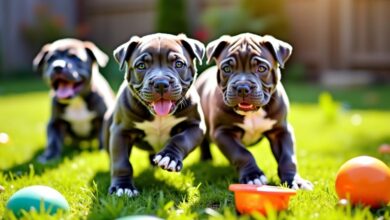Goldendoodle Color Chart – 7 Colors You Should Know
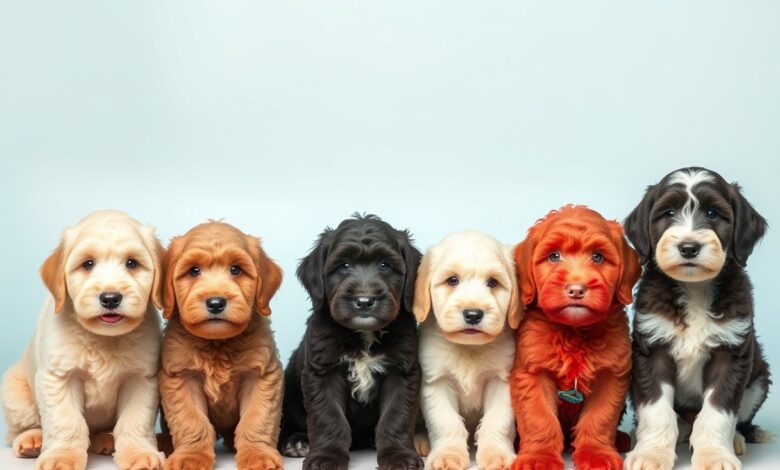
Most Goldendoodle owners are often captivated by their dog’s stunning coat colors, and understanding the Goldendoodle color chart can help you choose the perfect pup for your family. Whether you’re considering a new addition or just curious, knowing about the seven primary colors of Goldendoodles can enhance your bond with your furry friend. In this post, you’ll discover the characteristics and rarities of each color, allowing you to make an informed decision while celebrating the vibrant personalities that come with them. Let’s investigate the colorful world of Goldendoodles!
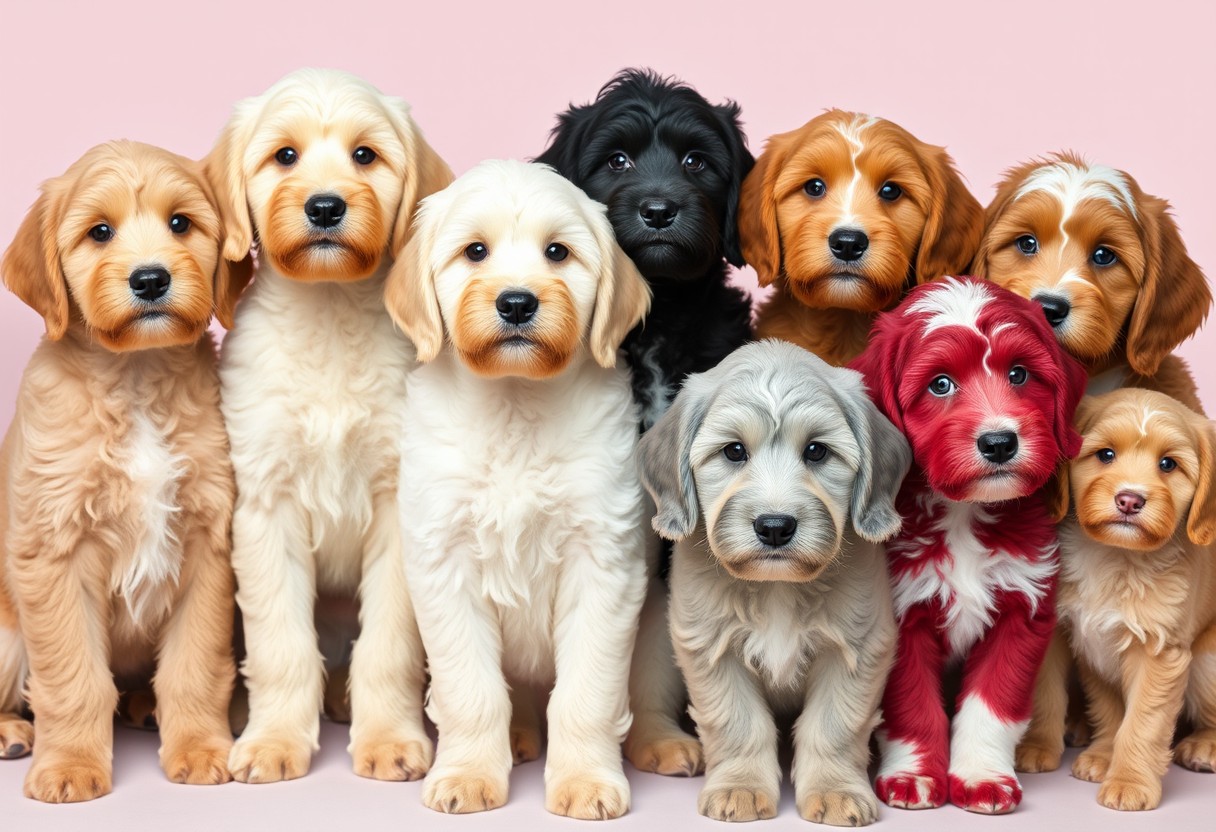
Key Takeaways:
- Variety of Colors: Goldendoodles come in a diverse range of colors including apricot, cream, black, red, chocolate, and more.
- Color Genetics: Understanding the genetic makeup of Goldendoodles can help predict the expected color of their puppies.
- Individual Preferences: Prospective Goldendoodle owners should consider personal preferences for color, as some breeds may have distinctive coat patterns and shades.
Overview of Goldendoodle Colors
While Goldendoodles come in a variety of stunning colors, each hue has its unique charm that appeals to different preferences. Understanding the various shades can help you make an informed decision when choosing your new furry friend. This overview will research into some of the most popular Goldendoodle colors, offering insight into what you can expect from each one.
Understanding the Goldendoodle Coat
For Goldendoodles, their coat is one of the most defining features and comes in a range of textures and colors. These hybrids typically have a wavy or curly coat, which not only looks attractive but also tends to be hypoallergenic. This means that you can enjoy the companionship of your furry friend while minimizing potential allergic reactions.
Genetics of Goldendoodle Coloring
Overview of Goldendoodle coloring reveals various genetic factors influencing their appearance. The colors you see in Goldendoodles depend largely on the coat colors of their parent breeds, which are the Poodle and the Golden Retriever. This combination can produce a multitude of shades, including but not limited to cream, apricot, red, chocolate, and black.
With a basic understanding of genetics, you’ll see how specific genes play a crucial role in determining your Goldendoodle’s color. The inheritance of coat color is a complex trait influenced by multiple genes; therefore, it’s vital to know that not all offspring will have the same color. Understanding these genetic influences can help you predict what colors may be present in your Goldendoodle’s litter, ensuring you can find the perfect shade for your home.
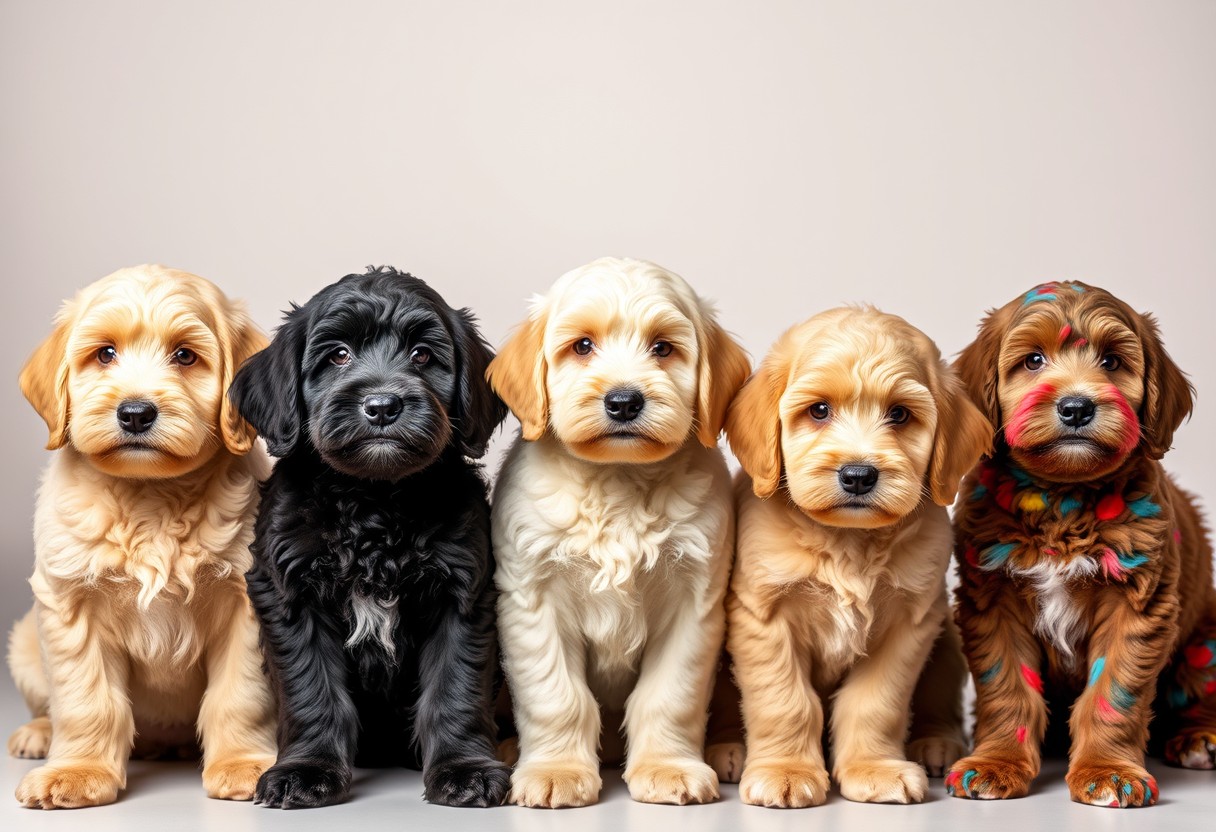
The Seven Main Colors of Goldendoodles
Even though Goldendoodles are known for their wonderful temperament and intelligence, their stunning variety of 18 Goldendoodle Colors & Patterns (With Pictures) adds to their charm. The seven main colors that you should be aware of include apricot, cream, gold, chocolate, black, red, and parti. Each color not only looks delightful but also has distinct traits that may appeal to your preferences when choosing your new furry friend.
Apricot
Goldendoodles can sport a beautiful apricot coat that varies from a light to a rich, deep hue. This warm tone is often loved for its sunshine-like brightness and its ability to stand out, making these dogs look particularly eye-catching and elegant.
Cream
One of the most sought-after colors, cream Goldendoodles exude a soft and elegant charm. This shade varies from a light beige to a brilliant white, perfect for individuals or families searching for a gentle, refined appearance.
Apricot or golden highlights can sometimes be found in cream Goldendoodles, enhancing their overall look. This versatility makes them a favorite among those who appreciate a classic, beautiful dog. Keep in mind that grooming is crucial to maintain their lovely coat.
Gold
Seven Goldendoodles come in a rich golden hue that often resembles the golden rays of the sun. This color can range from light to dark, giving you the opportunity to select the perfect shade to match your style.
With the golden coat comes a shiny and lustrous appearance that makes these dogs look healthy and vibrant. As they mature, their coat may lighten or darken, reflecting the uniqueness of each individual dog.
Chocolate
Chocolate Goldendoodles possess a stunning deep brown coat, which can vary from milk chocolate to dark chocolate shades. This rich coloring adds a delightful chocolatey appeal to your furry friend.
For instance, their luscious coat often requires regular grooming to keep it untangled and healthy. Along with their beautiful appearance, chocolate Goldendoodles tend to have a fun-loving and friendly personality, making them excellent companions.
Black
Black Goldendoodles have a striking, glossy coat that closely resembles the sleekness of a raven’s feather. This color brings a classic look to your canine companion.
Cream highlights may occasionally be found on their fur, adding depth and character to their appearance. Black Goldendoodles are known for their strong and playful nature, making them a fantastic choice for families looking for an energetic and loving pet.
Red
An eye-catching trait of red Goldendoodles is their vibrant and deep red coat. This striking color is often sought after by individuals who want their dog to stand out in a crowd.
To maintain the richness of their coat, regular grooming and care are vital. Red Goldendoodles are typically known for their affectionate and friendly demeanor, so they make wonderful companions for you and your family.
Parti
The unique parti color pattern in Goldendoodles brings together two distinct colors, often blending white with a variety of other shades such as black or apricot. This stunning pattern is as eye-catching as it is rare.
A parti Goldendoodle’s coat creates a lovely and whimsical appearance that is certain to attract attention. Their distinctive look combined with their outgoing personality makes them a great companion, ensuring you always have a talking point wherever you go.
Variations in Goldendoodle Colors
All Goldendoodles exhibit a fascinating array of colors, influenced by their Poodle and Golden Retriever genetics. While you may find the classic colors such as cream, apricot, and red, there are also unique variations that make each Goldendoodle stand out. These variations include patterns and combinations that can enhance the beauty and personality of your furry friend. Understanding these diverse color options can help you make an informed choice when selecting your new companion.
Phantom Patterns
Colors in phantom patterns refer to a striking combination of two or more colors, typically featuring a base color with specific markings of a different hue. For instance, a black Goldendoodle with tan markings on the eyebrows, throat, and legs showcases this stunning feature. This unique aesthetic not only adds visual appeal but also makes your dog truly one-of-a-kind. If you’re lucky enough to have a Goldendoodle with phantom coloring, you’ll be amazed by how these colors beautifully contrast against each other.
Merle Patterns
Phantom patterns add an exceptional flair to Goldendoodles, but those looking for a more adventurous coloration might be drawn to the merle patterns. These patterns consist of a mottled effect with varying shades and can create a striking look, making your dog stand out even more. However, it’s crucial to note that merle is a genetic pattern that can sometimes be associated with health risks. Always ensure your breeder is experienced and responsible to mitigate potential issues related to this coloring.
Patterns such as merle are not only visually captivating, but they also encompass intriguing genetics that may affect your Goldendoodle’s health. While the trademark marbling can be breathtaking, it is vital to be aware of the potential for hearing and vision issues in merle-coated dogs, particularly when bred with another merle. Therefore, if you are considering a Goldendoodle with this coloring, prioritize working with a reputable breeder who places emphasis on the health and genetic screenings of their breeding stock.
Choosing the Right Color for Your Goldendoodle
For many dog owners, the color of your Goldendoodle can be as important as its personality. Different colors not only affect the appearance of your pup but can also impact your emotional connection to them. When choosing a color, consider factors such as matching your lifestyle, existing home decor, or even just your personal taste. It’s vital to remember that each Goldendoodle’s coat is unique, and the color may change as they grow, so choose what resonates with you the most.
Personal Preference
For dog owners, personal preference plays a crucial role in choosing the right color for your Goldendoodle. You may have specific colors that you’re drawn to, which can be influenced by emotional ties or past experiences with similar breeds. Whether you prefer a classic cream, a striking red, or an abstract merle pattern, your personal connection to color can greatly enhance your enjoyment of your new furry companion.
Considerations for Allergies
To ensure a positive experience with your Goldendoodle, it’s vital to consider potential allergies related to their coat color. Some individuals may have sensitivities to specific pigments or particles that can be more pronounced in lighter coats. Before choosing your pup, consider possible allergic reactions you or family members may have. Consulting with a veterinarian or allergy specialist can provide guidance on which coat colors may be more suitable for your situation.
Understanding your allergies is key when selecting your Goldendoodle’s color. Some colors, particularly lighter hues, might show dirt and dander more easily, which can aggravate allergy symptoms. Additionally, if you or your family members have a history of allergies, consider how a dog’s coat may contribute to your symptoms. Regular grooming and cleaning can mitigate these effects, but it’s vital to choose a color that will not only match your aesthetic but also accommodate your health needs. Keep in mind that allergies vary from person to person, so personal assessment is highly recommended.
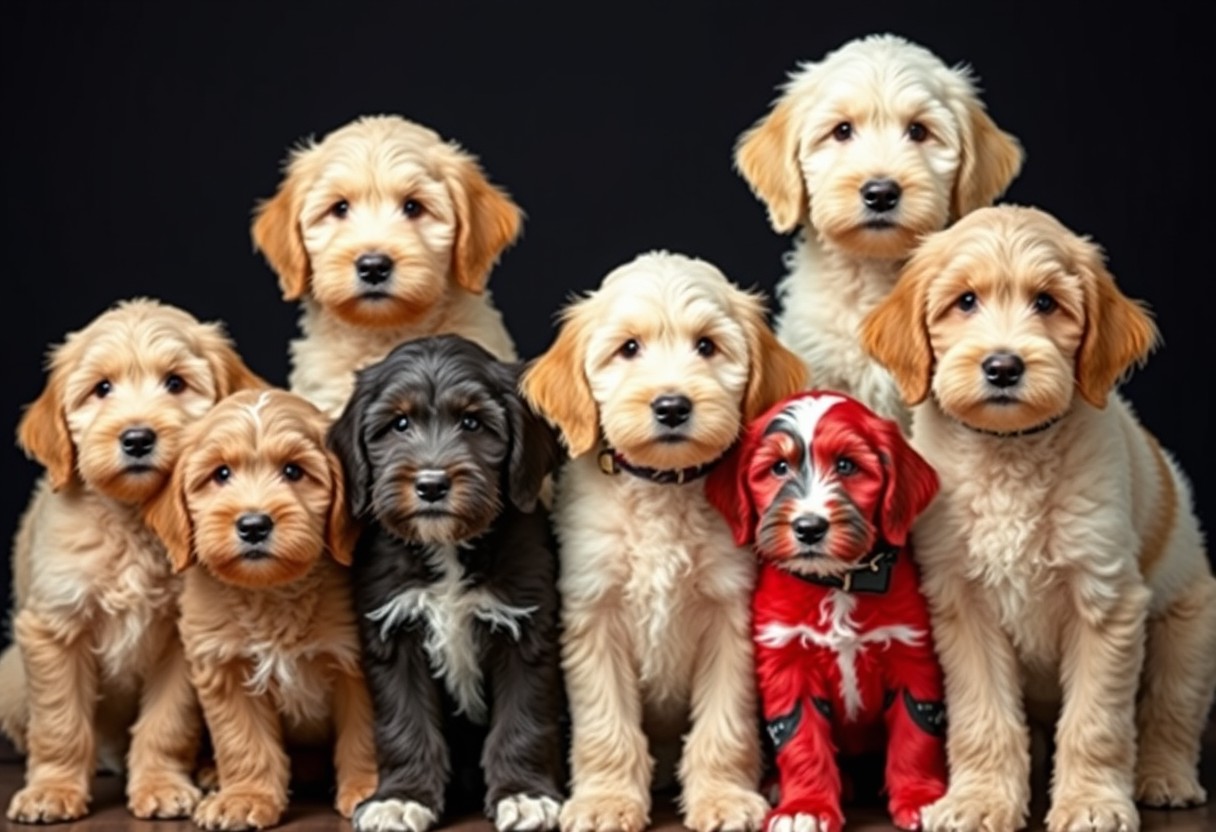
Caring for Your Goldendoodle’s Coat
Unlike some dog breeds, your Goldendoodle’s coat requires consistent care to keep it healthy and looking its best. Regular grooming sessions not only help prevent tangles and matting but also promote a shiny and vibrant coat. Incorporating brushing, bathing, and professional grooming into your routine will ensure that your Goldendoodle stays comfortable and free from skin issues.
Grooming Tips
Coat care is important for a happy Goldendoodle. Here are some crucial grooming tips:
- Brush your dog’s coat at least 2-3 times a week to prevent mats.
- Use a gentle, dog-specific shampoo during baths to maintain skin health.
- Trim nails monthly to avoid pain and discomfort.
- Schedule professional grooming every 6-8 weeks for optimal coat maintenance.
After all, proper grooming not only enhances your dog’s appearance but also its overall well-being.
Maintaining Color Vibrancy
An important aspect of caring for your Goldendoodle’s coat is maintaining its color vibrancy. Regular grooming and proper nutrition play a vital role in keeping your dog’s coat looking radiant and healthy.
Vibrancy can fade due to sun exposure, poor diet, or neglect. To ensure your Goldendoodle’s coat remains vibrant, provide a balanced diet rich in important nutrients and omega fatty acids. Regular grooming sessions help remove dirt and dead hair, which can dull the coat. Additionally, protect your dog’s coat from harsh sun and chemicals, as these can lead to color fading. If you notice drastic changes in your dog’s coat color, consult a veterinarian, as this could signal health issues. Emphasizing consistent care will keep your Goldendoodle looking its absolute best.
Summing up
Drawing together the information on the Goldendoodle color chart, you now have a clear understanding of the seven distinct colors that can enhance your furry companion’s unique appearance. Whether you prefer apricot, cream, chocolate, or any of the other colors, knowing these options allows you to make an informed decision that suits your taste and lifestyle. Keep this chart handy as you navigate your journey in choosing the perfect Goldendoodle that reflects your personal style and love for this delightful breed.
Q: What are the seven main colors of Goldendoodles listed in the Goldendoodle Color Chart?
A: The Goldendoodle Color Chart identifies seven primary colors that can be found in Goldendoodles. These colors include:
- 1. Apricot
- 2. Cream
- 3. Red
- 4. Black
- 5. Chocolate
- 6. Phantom (a combination of two colors, often black and tan)
- 7. Parti (white with patches of another color)
Each color can vary in shade and intensity, making every Goldendoodle unique!
Q: How does the coat type affect the appearance of a Goldendoodle’s color?
A: The coat type of a Goldendoodle significantly influences how the color appears. Goldendoodles can have three different coat types: curly, wavy, and straight. Curly coats tend to have a denser, more uniform color, which can make the colors appear richer. Wavy coats might display a bit of fading and can create a blending effect of shades, while straight coats may show a more pronounced color pattern. Additionally, the texture and condition of the coat can also modify how vibrant and noticeable the color is.
Q: Is it possible for Goldendoodles to change color as they grow, and how does this affect their overall appearance?
A: Yes, Goldendoodles can change color as they mature. Many puppies will start with a lighter shade that may darken as they grow older, while others may lighten. This color change is generally more noticeable in certain colors such as red or chocolate, which can develop a more muted tone over time. This transformation can affect their overall appearance, so prospective owners should be prepared for potential changes in coat color as their Goldendoodle ages. It’s crucial to have realistic expectations and remember that each dog’s unique genetic makeup plays a crucial role in its color development.


